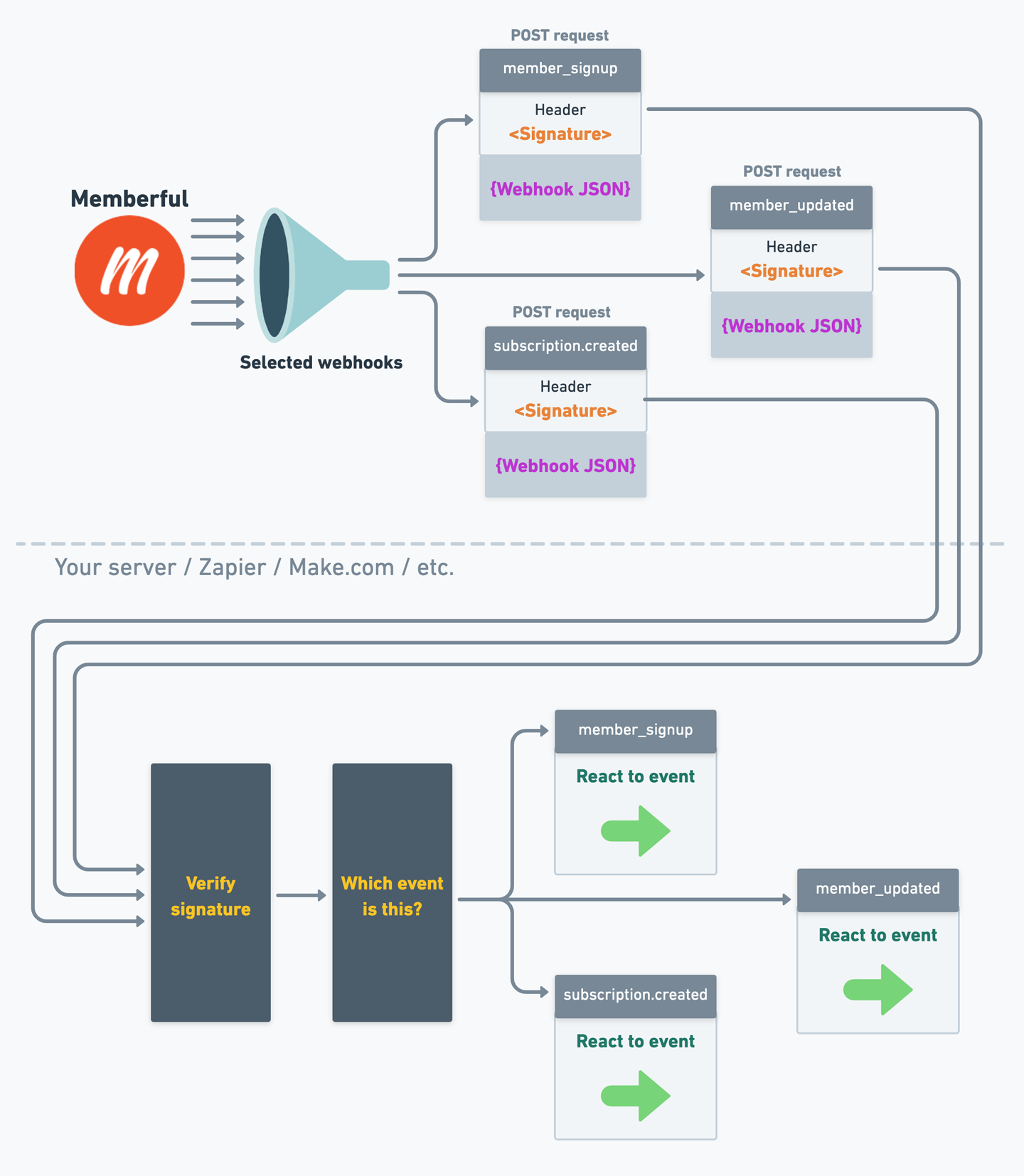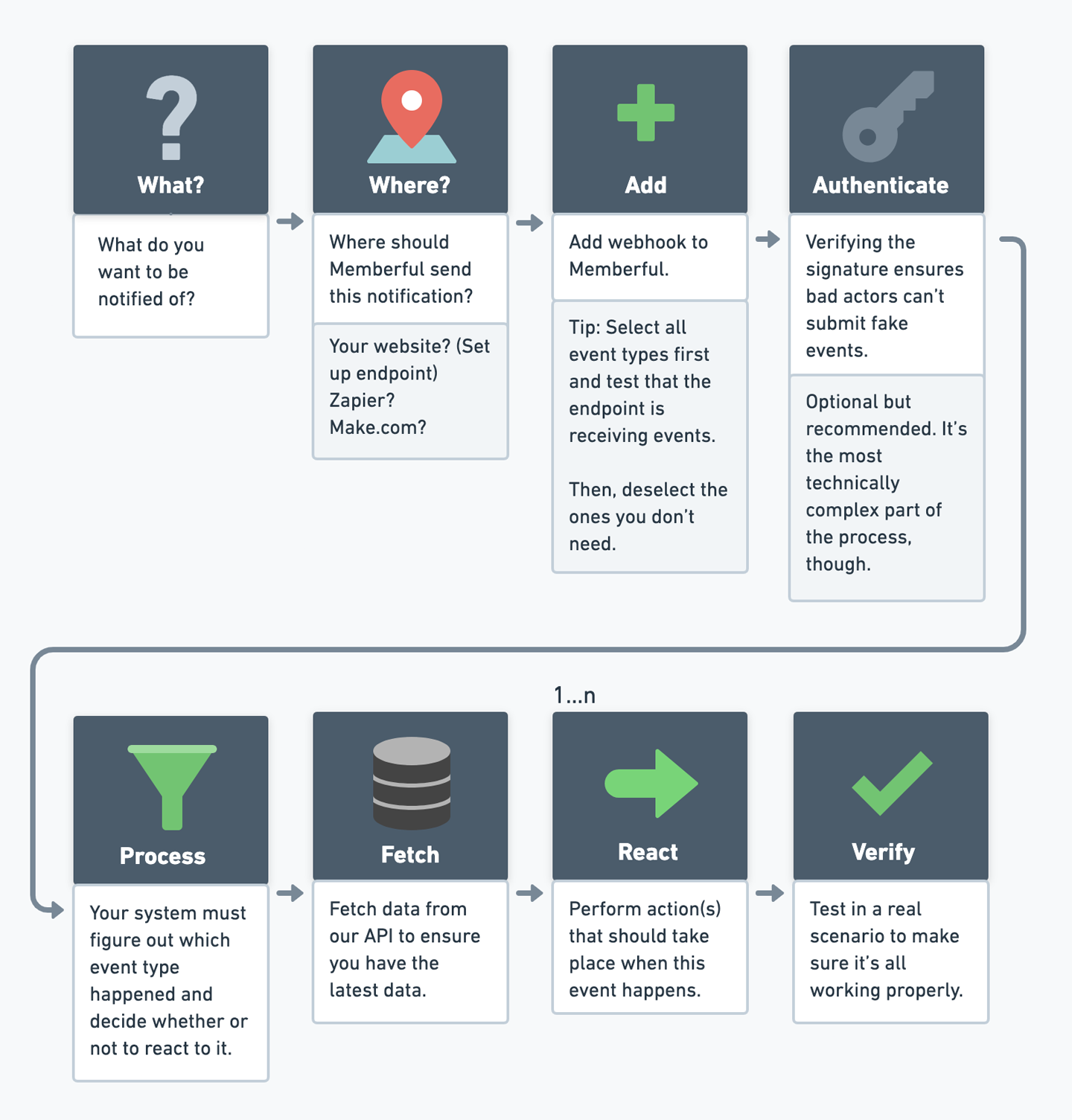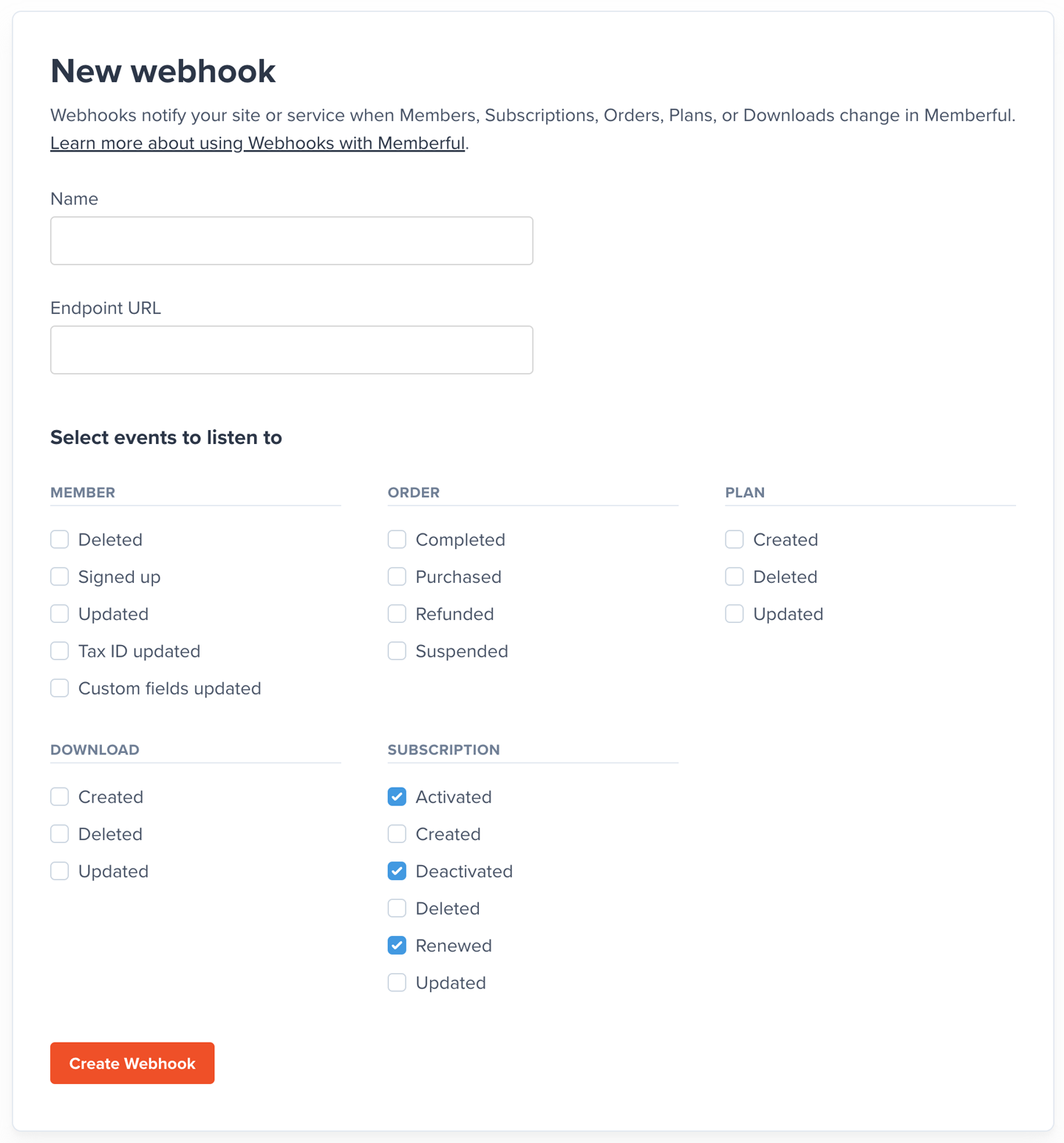Webhooks
Webhooks notify your website/app of events that happen in Memberful, such as when a member creates an account, a subscription is updated, or a plan is deleted.
This allows your app to react to the event and take action, such as creating an account on a different platform or syncing updated data to your own database.
Webhooks are very similar to Zapier triggers/events, except that you'll use custom code to react to those events.
Want code-free event notifications? Learn how to use Memberful with Zapier.
In this help doc:
- Webhook process overview
- Set up a webhook
- Create an endpoint
- Create and manage webhooks
- Fetch data from our API
- Verify requests
- How we handle failed requests
- Example app
- Webhook event reference
Webhook process overview
Here's an overview of the process by which Memberful sends webhooks to your application.

Memberful allows you to select which events you want to be notified about, so only events that pass that filter will result in a webhook.
When selected events happen, Memberful will send a webhook to your application (or to a service that can process webhooks, like Zapier or Make.com).
The webhook itself is simply a POST request with a header that contains a signature (to ensure it's legitimate) and a JSON payload that contains the event data.
When your endpoint receives the webhook, it should verify the signature and only process the event if it can verify that it's legitimate.
Then, your endpoint can take whatever action is appropriate for each event type.
Set up a webhook

To set up a webhook, follow these steps:
- Determine which events you want to be notified about.
- Create an endpoint where Memberful will send webhook notifications.
- Create a webhook in Memberful, select the events you want to be notified about, and specify the endpoint URL. It would be a good idea to trigger a test webhook at this point to make sure your endpoint is working properly.
- Implement verification of the webhook signature in your endpoint. This ensures that the webhook is legitimate and not a malicious request.
- In your code, process the webhook to determine which event happened.
- Fetch data from our API to ensure you are acting on the latest data.
- Take the appropriate action(s) for each event type.
- Test your webhook endpoint in a realistic scenario to make sure it's working properly.
Create an endpoint
You'll need to create an endpoint that will receive and process the webhooks.
This can be an endpoint on your site/app or an external service like Zapier or Make.com.
Memberful sends webhooks as POST requests with a JSON payload, so it's a good idea to ensure that your endpoint only responds to POST requests.
If you're having trouble and want to find out whether or not Memberful is sending webhooks to your endpoint, you can use a service like Webhook.site to create a temporary endpoint that will log all requests that are received, in realtime.
Create and manage webhooks
To create and manage webhooks in Memberful, navigate to Settings → Webhooks in your Memberful dashboard.
When creating or editing a webhook, you can specify the type of changes you want to be notified about. For example, you can specify that you ony want to be notified when a subscription is activated, deactivated, or renewed.

Fetch data from our API
When you receive a webhook, you should always fetch the latest version of the order/member/plan/download/etc. from Memberful's API to avoid issues with the order in which webhooks arrive.
Memberful does not guarantee delivery of events in the order in which they are generated.
Verify requests
You'll receive a secret key after you create a webhook endpoint.
Memberful signs every request with an X-Memberful-Webhook-Signature header that combines your secret key and the request payload so you can verify that the request is coming from us (an impersonator wouldn't know your secret key so they couldn't fake this header).
To generate the header, Memberful computes a hash-based message authentication code (HMAC) with SHA-256, using your Webhook secret as the key and the webhook's payload as the message.
To make sure the requests are coming from us, you should compute the HMAC signature yourself and compare it with the one that Memberful included in the header.
Here's an example using Ruby on Rails:
def webhook
request_signature = request.headers["X-Memberful-Webhook-Signature"]
secret = ENV["MEMBERFUL_WEBHOOK_SECRET"]
computed_signature = OpenSSL::HMAC.hexdigest("SHA256", secret, request.body.read)
if Rack::Utils.secure_compare(computed_signature, request_signature)
# Process webhook
end
end
And here's another example using Node.js:
const crypto = require('crypto');
const isWebhookValid = (payload, signature, secret) => {
const computedSignature = crypto
.createHmac('sha256', secret)
.update(payload)
.digest('hex');
return crypto.timingSafeEqual(
Buffer.from(computedSignature, 'hex'),
Buffer.from(signature, 'hex')
);
}
const secret = process.env.MEMBERFUL_WEBHOOK_SECRET;
const webhookPayload = request.body;
const webhookSignature = request.headers['X-Memberful-Webhook-Signature'];
if(isWebhookValid(webhookPayload, webhookSignature, secret)) {
// Process webhook
}
Note that we stored our secret token in an environment variable to avoid leaking it to our codebase and we're comparing the signatures using a constant-time algorithm to prevent timing attacks.
Ignore the request if the signatures don't match.
If you're having trouble with the signature verification, you can use an HMAC-SHA256 Online Generator Tool to test your hashing.
How we handle failed requests
If a webhook request does not receive a response code in the 2XX range (i.e. success) within 15 seconds, we'll try again multiple times with an exponential delay.
If an event can't be delivered after 24 hours of retries, we'll notify the account owner and give you three days to fix the problem. We will delete the endpoint if it's still failing after that period.
Example app
How you consume the webhooks is entirely up to you, but if you're looking for an example of how to get started, we built a simple Google Firebase app. The app takes any of the subscription webhooks, extracts the subscription object, and stores it in Firestore using the subscription ID as a key.
Webhook event reference
We've prepared an entire article that lists all of the webhook events and the data that is included with each event.
Related help docs: